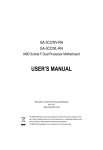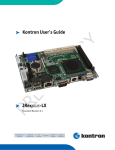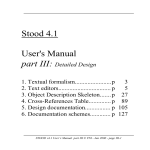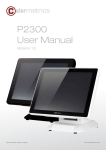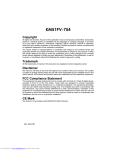Download Gigabyte GA-2CEWH Socket 940
Transcript
GA-2CEWH AMD Socket 940 Dual Processor Motherboard USER’S MANUAL AMD Opteron™ Socket 940 Dual Processor Motherboard Rev. 1003 GA-2CEWH Motherboard Table of Content Item Checklist ......................................................................................... 4 WARNING! ............................................................................................... 4 Chapter 1 Introduction ............................................................................. 5 Summary of Features .................................................................................. 5 GA-2CEWH Motherboard Layout ................................................................ 7 Chapter 2 Hardware Installation Process ................................................ 9 Step 1: Installing Processor and CPU Cooling Fan.................................. 10 Step1-1: Installing CPU ................................................................................................... 10 Step1-2: Installing Cooling Fan ........................................................................................ 12 Step 2: Install memory modules ................................................................ 13 Step 3: Install expansion cards ................................................................. 16 Step 4: Connect ribbon cables, cabinet wires, and power supply .......... 17 Step4-1:I/O Back Panel Introduction ................................................................................ 17 Step4-2: Connectors Introduction ..................................................................................... 20 Chapter 3 BIOS Setup .......................................................................... 35 Main ........................................................................................................... 37 Advanced ................................................................................................... 41 Hardware Monitoring ....................................................................................................... 42 BIOS Event Logging ....................................................................................................... 43 Processor ....................................................................................................................... 44 Hammer Configuration ..................................................................................................... 45 Chipset ........................................................................................................................... 48 Diskette Controller ........................................................................................................... 49 ATA Controller .................................................................................................................. 50 Integrated Network Interface ............................................................................................ 51 Integrated Audio ............................................................................................................... 53 Integrated USB ............................................................................................................... 54 Integrated 1394 ................................................................................................................ 55 2 Table of Content I/O Device Configuration ................................................................................................. 56 PCI Configuration ............................................................................................................ 58 Security ...................................................................................................... 61 Power ......................................................................................................... 64 Boot ............................................................................................................ 66 Boot Device Priority ........................................................................................................ 68 Exit ............................................................................................................. 69 Chapter 4 Technical Reference ............................................................ 72 Block Diagram ........................................................................................... 72 Chapter 5 Application Driver Installation ............................................... 73 A.NVDIA Chipset Driver Installation ................................................................................ 73 B.Broadcom LAN Driver Installation ................................................................................ 75 C.Realtek AC97 Driver Installation .................................................................................. 77 D.AMD System Interrupt Controller Driver Installation ...................................................... 78 E.DirectX 9.0 Driver Installation ....................................................................................... 80 Chapter 6 Appendix .............................................................................. 81 3 GA-2CEWH Motherboard Item Checklist ; The GA-2CEWH motherboard ; I/O shield x 1 ; SATA Cable x 4 ; CD for motherboard driver & utility ; FDD Cable x 1 ; GA-2CEWH user’s manual WARNING! Computer motherboards and expansion cards contain very delicate Integrated Circuit (IC) chips. To protect them against damage from static electricity, you should follow some precautions whenever you work on your computer. 1. 2. Unplug your computer when working on the inside. Use a grounded wrist strap before handling computer components. If you do not have one, touch both of your hands to a safely grounded object or to a metal object, such as the power supply case. 3. 4. Hold components by the edges and try not touch the IC chips, leads or connectors, or other components. Place components on a grounded antistatic pad or on the bag that came with the 5. components whenever the components are separated from the system. Ensure that the ATX power supply is switched off before you plug in or remove the ATX power connector on the motherboard. Installing the motherboard to the chassis… If the motherboard has mounting holes, but they don’t line up with the holes on the base and there are no slots to attach the spacers, do not become alarmed you can still attach the spacers to the mounting holes. Just cut the bottom portion of the spacers (the spacer may be a little hard to cut off, so be careful of your hands). In this way you can still attach the motherboard to the base without worrying about short circuits. Sometimes you may need to use the plastic springs to isolate the screw from the motherboard PCB surface, because the circuit wire may be near by the hole. Be careful, don’t let the screw contact any printed circuit write or parts on the PCB that are near the fixing hole, otherwise it may damage the board or cause board malfunctioning. 4 Introduction Chapter 1 Introduction Summary of Features Form Factor Motherboard 30.4cm x 33.0cm EATX size form factor, 8 layers PCB. GA-2CEWH Motherboard CPU Support Dual Opteron processors (Sledge Hammer) The HyperTransport link of the AMD Opteron processor is capable of operating at 400, 800, 1200, and 1600 MT/s. Supports L2/3 Cache with 1MB/2MB Chipset AMD-8132 Bridge HyperTransport PCI-X chipset provides two independent, high-performance PCI-X bus bridges, interated with a high-speed HyperTransport technology tunnel. NVIDIA nForce Pro 2200 enhance Hyper-Transport PCI-E interface NVIDIAnForce Pro 2050 combined with nForce Pro 2200 to Memory provide SLI feature Supports 4 * DDR socket slots for Primary CPU Supports 4 * DDR socket slots for Secondary CPU 1 CPU supports memory capacity up to 8GB 2 CPU supports memory capacity up to 16GB Supports registered ECC DDR-400 I/O Control Expansion Slots ITE 8712F Supports 2 x PCI-E x16 slots Supports 1 x PCI-E x1 slot Supports 2 x PCI-X 64Bit/133MHz Slots On-Board IDE Supports 1 x PCI 32Bit/33MHz Slot 2 IDE controllers on the NVIDIA nForce Pro 2200 Controller Hub provides IDE HDD/CD-ROM (IDE1, IDE2) with PIO, Bus Master (ATA133) operation modes. 5 GA-2CEWH Motherboard On-Board Peripherals 1 Floppy port supports 2 FDD with 360K, 720K,1.2M, 1.44M and 2.88M bytes. 1 Parallel port supports Normal/EPP/ECP mode 1 Serial port (COM) 8 x USB 2.0 2 x RJ45 LAN port 2 x IEEE 1394a 2 x PS/2 Connector RAID Supported Hardware Monitor Supports RAID 0, 1, 10 SMSC EMC6W201 CPU/System Fan Revolution detect CPU/System temperature detect System Voltage Detect Power Management Support Power Managerment Features Wake-on-LAN (WOL), USB, PCI, mouse Supports ACPI S1/S3/S4/S5 functions IEEE1394A Audio TI TSB43AB23 ALC 850 On-Board LAN PS/2 Connector Boradcom BCM 5751T & 5011U phy PS/2 Keyboard interface and PS/2 Mouse interface BIOS Additional Features Phoenix BIOS on 8Mb flash RAM SMBus Support IOAPIC Support Serial IRQ Support AC Recovery 6 Introduction GA-2CEWH Motherboard Layout Y Z 1 19 20 18 23 24 25 F 6 W 2 21 22 16 10 7 13 11 12 14 G X V 27 15 B H 26 U 8 C 4 D A 9 E S R Q T K 5 I J P L N O 3 17 M 7 GA-2CEWH Motherboard A. B. C. D. E. F. G. CPU0 1. CPU1 2. NVIDIA nForce Profession 20503. NVIDIA nForce Profession 22204. AMD8132 5. Broadcom BCM5751T 6. ITE IT8712F-A 7. SPDIF_IO_IN_OUT CENTER_SOUOUND FAN1 (CPU0 Fan) FAN5 (CPU1 Fan) FAN4 (Front Fan) FAN3 (Rear Fan) FAN2 (System Fan) H. I. J. K. L. M. N. O. P. Q. R. BIOS IDE1 IDE2 FDD F_1394 F_USB2 F_USB1 SATA2 SATA3 SATA0 SATA1 8. 9. 10. 11. 12. 13. 14. 15. 16. 17. 18. IO4_FAN CK-804_FAN SLOT1 SLOT2 SLOT3 SLOT4 SLOT5 SLOT6 DIMM4~7 DIMM 0~3 AUDIO S. F_Panel 19. USB_LAN2 T. U. V. W. X. Y. Z. Battery CI WOL (Wake On LAN) F_AUDIO WOR (Wake On Ring) AUX_IN CD_IN1 20. 21. 22. 23. 24. 25. 26. 27. USB_LAN1 REAR_1394 SPDIF_OUT LPT COM KB_MS (Keyboard/Mouse) ATX1 (SSI power connector) ATX2 (SSI power connector) 8 Hardware Installation Process Chapter 2 Hardware Installation Process To set up your computer, you must complete the following steps: Step 1- Install the Central Processing Unit (CPU) Step 2- Install memory modules Step 3- Install expansion cards Step 4- Connect ribbon cables, cabinet wires, and power supply Step 5- Setup BIOS software Step 6- Install supporting software tools Step 3 Step 2 Step 4 Step 1 Step 5 Step 4 Step 4 Step 1 9 Step 2 GA-2CEWH Motherboard Step 1: Installing Processor and CPU Cooling Fan Before installing the processor and cooling fan, adhere to the following cautions: 1. The processor will overheat without the heatsink and/or fan, resulting in permanent irreparable damage. 2. Never force the processor into the socket. 3. Apply thermal grease on the processor before placing cooling fan. 4. Please make sure the CPU type is supported by the motherboard. 5. If you do not match the CPU socket Pin 1 and CPU cut edge well, it will cause improper installation. Please change the insert orientation. Please use AMD approved cooling fan. Step1-1: Installing CPU Step 1. Rise the lever bar on the socket. Step 2. Aligning the pins of the processor with the socket, insert the processor into the socket. Step 3 Close the lever completely. Angling the Figure 1.Angling the rod to 65-degree maybe feel a kind of tight , and then continue pull the rod to 90rod to 650 degree when a noise “cough” made. Socket Actuation Lever Figure 2.Pull the rod to the 90-degree directly. 10 Hardware Installation Process Figure 3. A1 pin location on the Socket and Processor.Move the socket lever to the locked position while holding pressure on the center of the processor. Step 4. When the processor installation is completed, apply thermal grease to the processor(as shown in Figure 4) prior to installing the heatsink. AMD recommends using a high thermal conductivity grease for the thermal interface material rather than a phase change material. Phase change materials develop strong adhesive forces between the heatsink and processor. Removing the heatsink under such conditions can cause the processor to be removed from the socket without moving the socket lever to the unlocked position and then damage the processor pins or socket contacts. ** We recommend you to apply the thermal tape to provide better heat conduction between your CPU and heatsink. (The CPU cooling fan might stick to the CPU due to the hardening of the thermal paste. During this condition if you try to remove the cooling fan, you might pull the processor out of the CPU socket alone with the cooling fan, and might damage the processor. To avoid this from happening, we suggest you to either use thermal tape instead of thermal paste, or remove the cooling fan with extreme caution.) iFigure 4. Application of Thermal Grease to the processor. 11 GA-2CEWH Motherboard Step1-2: Installing Cooling Fan Step 1. Attach th cooling fan clip to the processor scoket. Align the heatsink assembly with the support frame mating with the backer plate standoffs as shown in Figure 5&6. Step 2. Coonect the processor fan cable to the processor fan connector. Note: ** We recommend you to buy the kind of cooling fan which is shown in Figure 8. This type of cooling fan will provide the best performance for heat releasing. Figure 5&6 Alignment of Heatsink Assembly with Standoffs Figure 7 Connecting CPU FAN connector 12 Hardware Installation Process Step 2: Install memory modules Before installing the processor and heatsink, adhere to the following warning: Please note that the DIMM module can only fit in one direction due to the one notches. Wrong orientation will cause improper installation. Please change the insert orientation. The motherboard has 8 dual inline memory module (DIMM) sockets. The BIOS will automatically detects memory type and size. To install the memory module, just push it vertically into the DIMM socket .The DIMM module can only fit in one direction due to the notch. Memory size can vary between sockets. DIMM6 DIMM5 DIMM7 DIMM4 DIMM0 DIMM1 13 DIMM3 DIMM2 GA-2CEWH Motherboard Total Memory Sizes With Registered DDR DIMM Devices used on DIMM 64 Mbit (4Mx4x4 banks) 64 Mbit (2Mx8x4 banks) 64 Mbit (1Mx16x4 banks) 128 Mbit(8Mx4x4 banks) 128 Mbit(4Mx8x4 banks) 128 Mbit(2Mx16x4 banks) 256 Mbit(16Mx4x4 banks) 256 Mbit(8Mx8x4 banks) 256 Mbit(4Mx16x4 banks) 1 DIMMx64/x72 256 MBytes 128 MBytes 64 MBytes 512 MBytes 256 MBytes 128 MBytes 1 GBytes 512 MBytes 256 MBytes 2 DIMMsx64/x72 512 MBytes 256 MBytes 128 MBytes 1 GBytes 512 MBytes 256 MBytes 2 GBytes 1 GBytes 512 MBytes 3 DIMMsx64/x72 768 MBytes 384 MBytes 192 MBytes 1.5 GBytes 768 MBytes 384 MBytes 3 GBytes 1.5 GBytes 768 MBytes 4 DIMMsx64/x72 1 GBytes 512 MBytes 256 MBytes 2 GBytes 1 GBytes 512 MBytes 4 GBytes 2 GBytes 1 GBytes 512 Mbit(32Mx4x4 banks) 2 GBytes 4 GBytes 4 GBytes 4 GBytes 512 Mbit(16Mx8x4 banks) 512 Mbit(8Mx16x4 banks) 1 GBytes 512 MBytes 2 GBytes 1 GBytes 3 GBytes 1.5 GBytes 4 GBytes 2 GBytes Installation Step: 1. Unlock a DIMM socket by pressing the retaining clips outwards. 2. Aling a DIMM on the socket such that the notch on the DIMM exactly match the notches in the socket. Firmly insert the DIMMinto the socket until the retaining clips snap back in place. 3. The processor supports 64-bit mode and 128-bit mode configuration of the DIMMs. In 64 bit mode, only DIMM 0 and 2 can be populated. Possible combinations of DIMMs in 64 bit mode are listed in Table 1. In 128 bit mode, minimum of two DIMMs is required to create the 128 bit bus; therefore, DIMMs can only be populated in even numbered pairs in slot 0 & 1, and 2& 3. Each logical DIMM must be madeof two identical DIMMs having the same device size on each and the same DIMM size. Regardless of mode, DIMM must be populated in order starting at the farest slotfrom the processor. Table 2 & 3 shows the possible combination of DIMMs for 128 mode. Not all possbile combinations are listed in the tables. 4. Installed DIMMs must be the same speed and must all be registered. For a list of suuported memrory, please refer to the table of previous page. 5. Reverse the installation steps when you wish to remove the DIMM module. Notch Locked Retaining Clip 14 Hardware Installation Process Table 1. Vaild DIMM Configuration for 64 bit Mode DIMM 0 (MB) X 256 X 512 X 1024 X 2048 X 4096 Note: X = Do not DIMM 2 (MB) 256 256 512 512 1024 1024 2048 2048 4096 4096 populate Table 2. Vaild DIMM Configuration for 128 bit Mode Logical DIMM 0 DIMM 0 (MB) X Ligical DIMM1 DIMM 1 (MB) X DIMM 2 (MB) 256 DIMM 3 (MB) 256 256 X 256 X 256 512 256 512 512 X 512 X 512 1024 512 1024 1024 X 1024 X 1024 2048 1024 2048 2048 X 2048 X 2048 4096 2048 4096 4096 4096 Note: X = Do Not populate 4096 4096 15 GA-2CEWH Motherboard Step 3: Install expansion cards 1. Read the related expansion card’s instruction document before install the expansion card into the computer. 2. Remove your computer’s chassis cover, screws and slot bracket from the computer. 3. Press the expansion card firmly into expansion slot in motherboard. 4. Be sure the metal contacts on the card are indeed seated in the slot. 5. Replace the screw to secure the slot bracket of the expansion card. 6. Replace your computer’s chassis cover. 7. Power on the computer, if necessary, setup BIOS utility of expansion card from BIOS. 8. Install related driver from the operating system. 16 Hardware Installation Process Step 4: Connect ribbon cables, cabinet wires, and power supply Step4-1:I/O Back Panel Introduction 17 GA-2CEWH Motherboard PS/2 Keyboard and PS/2 Mouse Connector To install a PS/2 port keyboard and mouse, plug the mouse to the upper port (green) and the keyboard to the lower port (purple). Parallel Port / Serial Port This connector supports 1 standard COM port and 1 Parallel port. Device like printer can be connected to Parallel port ; mouse and modem etc can be connected to Serial port. / SPDIF IN / 1394 Connectors / USB / LAN Ports Before you connect your device(s) into USB connector(s), please make sure your device(s) such as USB keyboard, mouse, scanner, zip, speaker...etc. have a standard USB interface. Also make sure your OS supports USB controller. If your OS does not support USB controller, please contact OS vendor for possible patch or driver updated. For more information please contact your OS or device(s) vendors. LAN ports provided Internet connection is Gigabit Ethernet, providing data transfer speeds of 10/ 100/1000Mbps. LAN LED Description Name Color LAN Green Link/Activity Green Condition ON Description LAN Link / no Access BLINK OFF LAN Access Idle ON OFF 100Mbps connection 10Mbps connection ON BLINK 1Gbps connection Port identification with 1Gbps connection Green Green ON BLINK 100Mbps connection Port identification with 10 or 100Mbps connection - OFF 10Mbps connection 10/100 LAN Green Speed GbE LAN Yellow Speed Yellow 18 Hardware Installation Process Audio Connectors Line Out (Front Speaker) Line In (Rear Speaker) MIC In (Center and Subwoofer) ¾ After install onboard audio driver, you may connect speaker to Line Out jack, micro phone to MIC In jack. Device like CD-ROM , walkman etc can be connected to Line-In jack. Please note: You are able to use 2-/4-/6- channel audio feature by S/W selection. If you want to enable 6-channel function, you have 2 choose for hardware connection. Method1: Connect “Front Speaker” to “Line Out” Connect “Rear Speaker” to “Line In” Connect “Center and Subwooferr” to “MIC In “. 19 GA-2CEWH Motherboard Step4-2: Connectors Introduction R S T 4 U 3 1 P B O N L A Y X Z K M V 2 E G F C 5 6 D J I H W Q 20 Connector Introduction A) B) C) D) E) F) G) H) I) J) K) L) M) N) O) P) Q) AXT2 ATX1 IDE1 IDE2 FDD F_USB2 F_USB1 SATA0 SATA1 SATA2 SATA3 CI F_Panel WOL WOR F_Audio F_1394 R) AUX_IN S) CD_IN1 T) SPDIF_IO U) SUR_CEN1 V) BT W) FAN1 X) FAN5 Y) IO4_FAN Z) CK804_FAN 1) FAN2 2) FAN4 3) FAN3 4) PWR_JP 5) CLR_BIOS 6) BIOS_RE 21 GA-2CEWH Motherboard A ) ATX2 13 24 ¾ AC power cord should only be connected to your power supply unit after ATX power cable and other related devices are firmly connected to the mainboard. 1 12 PIN No. Definition 1 +3.3V 2 3 +3.3V GND 4 5 +5V GND 6 7 +5V GND 8 9 POK 5VSB 10 11 +12V +12V 12 13 +3.3V +3.3V 14 15 -12V GND 16 17 PSON GND 18 19 GND GND 20 21 -5V +5V 22 23 +5V +5V 24 GND B ) ATX1 8 7 2 1 Pin No. 1 2 3 4 5 6 7 8 Definition GND +12v GND +12V GND +12V GND +12V ¾This connector (ATX +12V) is used only for CPU Core Voltage. 22 Connector Introduction C / D ) IDE 1/2 Please connect first harddisk to IDE1 and connect CDROM to IDE2. The red stripe of the ribbon cable must be the same side with the Pin1. 1 2 39 40 E ) FDD1 (Floppy Connector) Please connect the floppy drive ribbon cables to FDD. It supports 360K,720K,1.2M,1.44M and 2.88Mbytes floppy disk types. The red stripe of the ribbon cable must be the same side with the Pin1. 1 2 33 34 23 GA-2CEWH Motherboard F ) F_ USB2 (Front USB Connector) PIN No. 11 1 12 2 Definition 1 Do Not Connect 2 Do Not Connect 3 Power 4 Power 5 Data- 6 Data- 7 Data+ 8 Data+ 9 GND 10 GND 11 Key 12 NC G ) F_ USB1 (Front USB Connector) PIN No. 10 9 2 1 Definition 1 Power 2 Power 3 Data- 4 Data- 5 Data+ 6 Data+ 7 GND 8 GND 9 Key 10 NC ¾ Be careful with the polarity of the front panel USB connector. Check the pin assignment while you connect the front panel USB cable. Please contact your nearest dealer for optional front panel USB cable. 24 Connector Introduction H / I / J / K ) SATA0/1/2/3 (Serial ATA Connector) 7 1 SATA0~3 Pin No. 1 2 3 4 5 6 7 Definition GND TXP TXN GND RXN RXP GND SATA0~3 L ) CI (CASE OPEN) This 3 pin connector allows your system to enable or disable the “case open” item in BIOS if the system case begin remove. Pin No. 1 2 3 25 Definition GND INTRUDER# NC GA-2CEWH Motherboard M ) F_Panel1 (2X10 Pins) Please connect the power LED, PC speaker, reset switch and power switch etc of your chassis front panel to the front panel jumper according to the pin assignment below. IDE Hard Disk Active LED HD_LED+ HD_LED+ RST _SWRST_SW+ NC Power Sleep LED 1 2 PWE_LED+ PWE_LED PWR_BTN+ PWR _BTN+5V NC NC SPK Reset Switch 19 20 Pin No 1 2 3 4 5 6 7 8 9 10 11 12 13 14 15 16 17 18 19 20 Connector Speaker Connector Signal Name Description HD_LED+ PWE_LEDHD_LEDPWE_LEDRST_SWPWR_BTN+ RST_SW+ PWR_BTNNC KEY KEY KEY KEY +5V NC NC NC NC NC SPEAK- Hard Disk LED pull up (330 ohm) Power Sleep LED (Pull up 330 ohm) Hard Disk Active LED Signal Suspend LED Button(Blinking) Reset Switch Front Panel Power On/Off Button Signal Reset Switch Front Panel Power On/Off Button Signal(GND) No Connect KEY KEY Pin KEY KEY Speaker connector (5V Standby) No Connect No Connect No Connect No Connect No Connect Speaker connector 26 Soft Power Connector Introduction N ) WOL (Wake On LAN Connector) This connector allows the remove servers to manage the system that installed this mainboard via your network adapter which also supports WOL. 1 Pin No. 1 2 3 Definition +5V SB GND Signal O ) WOR (Wake on Ring Connector) 1 Pin No. 1 2 27 Definition Ring GND GA-2CEWH Motherboard P ) F_Audio (Front Audio connector) If you want to use Front Audio connector, you must remove 5-6, 9-10 Jumper. In order to utilize the front audio header, your chassis must have front audio connector. Also please make sure the pin assigment on the cable is the same as the pin assigment on the MB header. To find out if the chassis you are buying support front audio connector, please contact your dealer. 10 9 2 1 Pin No. Definition 1 MIC 2 GND 3 REF 4 POWER 5 FrontAudio(R) 6 RearAudio(R) 7 Reserved 8 No Pin 9 FrontAudio (L) 10 RearAudio(L) Q )F_1394 (Front IEEE 1394 connector) 1 2 9 10 28 Pin No. 1 2 3 4 5 6 7 8 9 10 Definition TPA+ TPAGND GND TPB+ TPBPower Power Key NC Connector Introduction R ) AUX_IN ( AUX In Connector) Connect other device(such as PCI TV Tunner audio out)to the connector. Pin No. 1 2 3 4 Definition AUX-L GND GND AUX-R 1 S ) CD_IN (CD IN,Black) Connect CD-ROM or DVD-ROM audio out to the connector. Pin No. 1 2 3 4 1 29 Definition CD-L GND GND CD_R GA-2CEWH Motherboard T )SPDIF_IO (Red Connector) The SPDIF output is capable of providing digital audio to external speakers or compressed AC3 data to an external Dolby Digital Decoder. Use this feature only when your stereo system has digital input function. 6 5 2 1 SPDIF Pin No. 1 2 3 4 5 6 Definition P5V Pin Removed SPDIFO SPDIFI GND GND U ) SUR_CEN1 (Center Suround Connector) Please contact your nearest dealer for optional SUR_CEN cable. 6 5 2 1 30 Pin No. 1 2 3 4 5 6 Definition SURR_OUT_L SURR_OUT_R AUDGND Pin Removed CENTER_OUT LFE_OUT Connector Introduction V ) BT (Battery) + CAUTION Danger of explosion if battery is incorrectly replaced. Replace only with the same or equivalent type recommended by the manufacturer. Dispose of used batteries according to the If you want to erase CMOS... 1.Turn OFF the computer and unplug the power cord. 2.Remove the battery, wait for 30 second. 3.Re-install the battery. 4.Plug the power cord and turn ON the computer. manufacturer’s instructions. W / X ) FAN1 /FAN 5 (CPU 0/1 Fan Connectors) Please note, a proper installation of the CPU cooler is essential to prevent the CPU from running under abnormal condition or damaged by overheating.The CPU fan connector supports Max. current up to 600 mA. Note: Pin 4 is reserved for 4-pins Fan connector 1 Pin No. 1 2 3 4 1 CPU1_FAN CPU0_FAN 31 Definition GND +12V Sense Control GA-2CEWH Motherboard Y ) IO4_FAN (NVIDIA IO-4 Chipset FAN connector) If you installed wrong direction, the Chip Fan will not work. Sometimes will damage the Chip Fan. 1 Pin No. 1 2 3 Definition GND 12V Sense Z ) CK804_FAN (NVIDIA CK804 Chipset FAN connector) If you installed wrong direction, the Chip Fan will not work. Sometimes will damage the Chip Fan. 1 32 Pin No. 1 2 3 Definition GND 12V Sense Connector Introduction 1 / 2 / 3 ) FAN2 / 4 / 3 (Front Fan / Rear Fam / System FAN) This connector allows you to link with the cooling fan on the system case to lower the system temperature. FAN4 FAN2 1 Pin No. 1 2 3 4 Definition GND 12V Sense Control FAN5 4 ) PWR_JP (PS/2 Wake Up Power Source Jumper) 1 1 33 1-2 close:support PS2 wake up from S3 (Default) 2-3 close: Disable this function GA-2CEWH Motherboard 5 ) CLR_CMOS1 (Clear CMOS Function) You may clear the CMOS data to its default values by this jumper. Default value doesn’t include the “Shunter” to prevent from improper use this jumper. To clear CMOS, temporarily short 1-2 pin. 1 1 1-2 close: Clear CMOS 2-3 close: Normal (Default) 6 ) BIOS_RE (BIOS Recovery Function) 1 1 1-2 close: Enable BIOS Recovery function 2-3 close: Disable BIOS Recovery function (Default) 34 BIOS Setup Chapter 3 BIOS Setup BIOS Setup is an overview of the BIOS Setup Program. The program that allows users to modify the basic system configuration. This type of information is stored in battery-backed CMOS RAM so that it retains the Setup information when the power is turned off. ENTERINGSETUP Power ON the computer and press <F2> immediately will allow you to enter Setup. CONTROLKEYS <Ç> Move to previous item <È> Move to next item <Å> Move to the item in the left hand <Æ> Move to the item in the right hand <Esc> Main Menu - Quit and not save changes into CMOS Status Page Setup Menu and Option Page Setup Menu - Exit current page and return to Main Menu <+/PgUp> Increase the numeric value or make changes <-/PgDn> Decrease the numeric value or make changes <F1> General help, only for Status Page Setup Menu and Option Page Setup Menu <F2> Reserved <F3> Reserved <F4> Reserved <F5> Restore the previous CMOS value from CMOS, only for Option Page Setup Menu <F6> Reserved <F7> Load the Optimized Defaults <F8> Reserved <F9> Reserved <F10> Save all the CMOS changes, only for Main Menu 35 GA-2CEWH Motherboard GETTINGHELP Main Menu The on-line description of the highlighted setup function is displayed at the bottom of the screen. Status Page Setup Menu / Option Page Setup Menu Press F1 to pop up a small help window that describes the appropriate keys to use and the possible selections for the highlighted item. To exit the Help Window press <Esc>. z Main This setup page includes all the items in standard compatible BIOS. z Advanced This setup page includes all the items of AMI special enhanced features. (ex: Auto detect fan and temperature status, automatically configure hard disk parameters.) z Security Change, set, or disable password. It allows you to limit access the system and setup. z Power This setup page includes all the items of Green function features. z Boot This setup page include all the items of first boot function features. z Exit There are five optionsin this selection: Exit Saving Changes, Exit Discarding Changes, Load Optimal Defaults, Load Failsafe Defaults, and Discard Changes. 36 BIOS Setup Main Once you enter Phoenix BIOS Setup Utility, the Main Menu (Figure 1) will appear on the screen. Use arrow keys to select among the items and press <Enter> to accept or enter the sub-menu. Phoenix TrustedCore(tm) Setup Utility Main Advanced Security Power System Time: [00:13:12] System Date: [07/14/2005] Disktte A [1.44MB] Standard IDE drive 1 [None] Standard IDE drive 2 [None] Standard IDE drive 3 [None] Standard IDE drive 4 [None] Installed OS Boot Exit Item Specific Help [Other] System Information System Memory 640KB Extended Memory 1022MB F1: Help Esc: Exit KL: Select Item IJ: Select Menu + -: Change Values F5: Setup Defaults Enter: Select Sub-Menu F10: Save&Exit Figure 1: Main System Time The time is calculated based on the 24-hour military time clock. Set the System Time (HH:MM:SS) System Date Set the System Date. Note that the “Day” automatically changed after you set the date. (Weekend: DD: MM: YY) (YY: 1099~2099) Note!! “ ”Indicates DISPLAY ONLY 37 GA-2CEWH Motherboard Diskette A This category identifies the type of floppy disk drive A that has been installed in the computer. Disabled Disable this device. 360KB 5 1/4 inch AT-type high-density drive; 360K byte capacity 1.2MB 3 1/2 inch AT-type high-density drive; 1.2M byte capacity 720K 31/2 inch double-sided drive; 720K byte capacity 1.44M 3 1/2 inch double-sided drive; 1.44M byte capacity. * Note: The 1.25MB,3 1/2 reference a 1024 byte/sector Japanese media format. The 1.25MB,31/2 diskette requires 3-Mode floppy-disk drive. Standard IDE Drive 1 /2 /3 /4 The category identifies the types of hard disk from drive C to F that has been installed in the computer. There are two types: auto type, and manual type. Manual type is user-definable; Auto type which will automatically detect HDD type. Note that the specifications of your drive must match with the drive table. The hard disk will not work properly if you enter improper information for this category. If you select User Type, related information will be asked to enter to the following items. Enter the information directly from the keyboard and press <Enter>. Such information should be provided in the documentation form your hard disk vendor or the system manufacturer. TYPE 1-39: Predefined types. Users: Set parameters by User. Auto: Set parameters automatically. (Default Vaules) CD-ROM: Use for ATAPI CD-ROM drives or double click [Auto] to set all HDD parameters automatically. ATAPI Removable: Removable disk drive is installed here. 38 BIOS Setup Multi-Sector Transfer This field displays the information of Multi-Sector Transfer Mode. Disabled: The data transfer from and to the device occurs one sector at a time. Auto: The data transfer from and to the device occurs multiple sectors at a time if the device supports it. Maximum Capacity This field displays the maximum capacity of primary IDE master. LBA Mode This field shows if the device type in the specific IDE channel support LBA Mode. 32-Bit I/O Enable this function to max imize the IDE data transfer rate. Transfer Mode This field shows the information of Teansfer Mode. Ultra DMA Mode This filed displays the DMA mode of the device in the specific IDE channel. Installed OS This category allows you to select the operating system which you will use commonly. Other Select ‘Other’ if your operating system is not on the item list. Windows 32bit Select Windows 32 bit as the operating system that you use commonly . Windows 64bit Select Windows 64 bit as the operating system that you use Linux Select Linux as the operating system that you use commonly . commonly . 39 GA-2CEWH Motherboard System Information This category includes the information of BIOS Version, BIOS Date,and MAC address. System Memory The POST of the BIOS will determine the amount of base (or conventional) memory installed in the system. The value of the base memory is typically 512K for systems with 512K memory installed on the motherboard, or 640 K for sy stems with 640K or more memory installed on the motherboard. ExtendedMemory The BIOS determines how much extended memory is present during the POST. This is the amount of memory located above 1 MB in the C PU’s memory address map. 40 BIOS Setup Advanced Phoenix TrustedCore(tm) Setup Utility Main Advanced Security Power Hardware Monitoring Boot Exit Item Specific Help BIOS Event Logging Processor Hammer Configuration Chipset Diskette Controller ATA Controller Integrated Network Interface Integrated Audio Integrated USB Integrated 1394 I/O Device Configuration PCI Configuration Reset Configuration [No] Option ROM Placement [Disabled] F1: Help Esc: Exit KL: Select Item IJ: Select Menu + -: Change Values F5: Setup Defaults Enter: Select Sub-Menu F10: Save&Exit Figure 2: Advanced About This Section: Advanced With this section, allowing user to configure your system for basic operation. User can change the system’s default boot-up sequence, keyboard operation, chipset configuration, PCI configuration and System Hardware health monitoring. 41 GA-2CEWH Motherboard Hardware Monitoring PhoenixTrustedCore(tm) Setup Utility Advanced Hardware Monitoring Item Specific Help Realtime Sensors: F1: Help Esc: Exit KL: Select Item IJ: Select Menu + -: Change Values F5: Setup Defaults Enter: Select Sub-Menu F10: Save&Exit Figure 2-1: Hardware Monitoring Realtime Sensors This category displays system health information and voltage detection. System health information includes CPU0/1 Temperature, Rear Temperature, FAN1/2/3/4/5. Voltage detection includes information of 12V, 5V, 5VSB, 3.3V, and Battery. 42 BIOS Setup BIOS Event Logging PhoenixTrustedCore(tm) Setup Utility Advanced BIOS Event Logging Item Specific Help BIOS Event Logging [Enabled] View DMI External Log [Enter] Clear BIOS event logging [Disabled] F1: Help Esc: Exit KL: Select Item IJ: Select Menu + -: Change Values F5: Setup Defaults Enter: Select Sub-Menu F10: Save&Exit Figure 2-2: BIOS Event Logging Boot Event Logging Enabled When this item is set to enabld, all system errors will be logged to BIOS Disabled Error will not be logged to the BIOS event log. event log. (Default vaule) View DMI external Log Press [Enter] to view the contents of the DMI Event Log. Clear BIOS event log Enabled Setting to enabled, system will clear BIOS event log after rebooting system. Disabled Disable this function. 43 GA-2CEWH Motherboard Processor PhoenixTrustedCore(tm) Setup Utility Advanced Processor Item Specific Help CPU0 Type: AMD Optern(tm) Processor 244 CPU0 Speed: 1800Mz CPU0 ID: 0751 CPU0 Patch ID: 004D MPS Version: [1.4] F1: Help Esc: Exit KL: Select Item IJ: Select Menu + -: Change Values F5: Setup Defaults Enter: Select Sub-Menu F10: Save&Exit Figure 2-3: Processor CPU Type/ Speed / ID / Patch ID All items on this menu cannot be modified. This displays the installed CPU physical information. MPS Version This option allows user to configure the multiprocessor(MP) specification revision level. Some operating system will require 1.1 for compatibility reasons. 1.4 Support MPS Version 1.4 . (Default) 1.1 Support M PS Version 1.1. 44 BIOS Setup Hammer Configuration PhoenixTrustedCore(tm) Setup Utility Advanced Hammer Configuration Item Specific Help HT-LDT Frequency: [100MHz] MTRR Mapping Methods: [Continuous] Memhole mapping [Hardware] ECC: [Enabled] ECC Scrub Redirection [Enabled] 4-bit ECC: [Disabled] DCAHE ECC Scrub CTL: [Disabled] L2 ECC Scrub CTL: [Disabled] Dram ECC Scrub CTL: [Disabled] F1: Help Esc: Exit KL: Select Item IJ: Select Menu + -: Change Values F5: Setup Defaults Enter: Select Sub-Menu F10: Save&Exit Figure 2-4: Hammer Configuration HT-LDT Frequency Manually select HT-LINK frequency. Options 200MHz, 400MHz, 600MHz, 800MHz, and 1000MHz (Default values) 45 GA-2CEWH Motherboard MTRR Mapping Method Select the CPU Memory Type Range Register (MTRR) mapping method. Continuous Default method. (Default value) Dicrete Compatible with Linux AGP. Memhole mapping Remapping scheme of PCI memory hole. Hardware Select Hardware as the PCI memory hole. (Default value) Software Select Software as the PCI memory hole. Disabled Disable this function. ECC ECC check / correct mode. This is a global enable function for all blocks within CPU core and north bridge. Note that after loading setup defaults, restart and enter setup to access DRAM ECC setup option. Enabled Enable ECC function. (Default value) Disabled Disable this function. ECC Scrub Redirection Enabling ECC Scrubber to correct errors detected in Dram during normal CPU request (Foreground scrubbing). Enabled Enable ECC Scrub Redirection function. (Default) Disabled Disable this function. 4-bit ECC This option provide user to function Chip-Kill ECC on nodes without all x4 ECC capable DIMMs. Enabled Enable 4-bit ECC mode on Nodes with ECC capable DIMMs. Disabled Disable this function. (Default value) 46 BIOS Setup DCACHE ECC Scrub CTL This option allows user to set the rates of background scrubbing for DCACHE lines. Enabled Set the rates of background scrubbing for DCACHE lines. Disabled Disable this function. (Default value) L2 ECC Scrub CTL This option allows user to set the rates of background scrubbing for L2 cache lines. Enabled Set the rates of background scrubbing for L2 cache lines. Disabled Disable this function. (Default value) Dram ECC Scrub CTL This option allows user to set the rates of background scrubbing for Dram. (In addition to normal ECC scrubbing for system request) Note that background agent works independently of CPU requests and bus master, but cannot be enabled without first enabling Dram ECC. Options 1.31 ms (Default value), 2.62 ms, 5.24 ms, 10.49 ms, 20.97 ms, 42.0 ms, 84.0 ms. Disabled Disable this function. 47 GA-2CEWH Motherboard Chipset PhoenixTrustedCore(tm) Setup Utility Advanced Chipset Item Specific Help DRAM Bank Interleaving [Auto] NODE memory Interleaving [Auto] ACPI SRAT Table [Disabled] ECC Memory Checking [Enabled] F1: Help Esc: Exit KL: Select Item IJ: Select Menu + -: Change Values F5: Setup Defaults Enter: Select Sub-Menu F10: Save&Exit Figure 2-5: Chipset DRAM Bank Interleaving Auto BIOS will automatically detect capability on each node. (Default value) Disabled Disable this function. NODE Memory Interleaving Auto BIOS will automatically detect capability on each node. (Default value) Disabled Disable this function. ACPI SRAT Table Enabled Enable ACPI 2.0 static resources affinity table or NUMA system. (Default value) Disabled Disable this function. ECC Memory Checking Enabled All memory modules in the system support parity ECC mode. Disabled Disable this function. (Default value) 48 BIOS Setup Diskette Controller PhoenixTrustedCore(tm) Setup Utility Advanced Diskette Controller Item Specific Help Diskette Controller F1: Help Esc: Exit [Enabled] KL: Select Item IJ: Select Menu + -: Change Values F5: Setup Defaults Enter: Select Sub-Menu F10: Save&Exit Figure 2-6: Diskette Controller Diskette Controller Auto BIOS will automatically start configuration for floppy diskette controller. (Default value) Enabled Enable floppy diskette controller. Disabled Disable this function. 49 GA-2CEWH Motherboard ATA Controller PhoenixTrustedCore(tm) Setup Utility Advanced ATA Controller Item Specific Help P-ATA Interface [Pata 1/2 + P-ATA 3/4] S-ATA Interface [Enabled] S-ATA Mode [Native] F1: Help Esc: Exit KL: Select Item IJ: Select Menu + -: Change Values F5: Setup Defaults Enter: Select Sub-Menu F10: Save&Exit Figure 2-7: ATA Controller P-ATA Interface PATA1/2 Specify the Parallel ATA Channel to PATA 1/2. PATA 3/4 Specify the Parallel ATA Channel to PATA 3/4. PATA1/2 + PATA3/4 Enable both the Parallel ATA Channel. Disabled Disable the device. SATA Interface Enabled Enable first serial ATA device. Disabled Disable this device. SATA Mode Native Serial ATA configured in native mode.Some operating systems do not support native IDE devices. RAID This option requires two identical SATA devices. 50 BIOS Setup Integrated Network Interface PhoenixTrustedCore(tm) Setup Utility Advanced Integrated Network Interface Item Specific Help Integrated Network Interface 1 (Broadcom) Integrated Network Interface 2 (NVDIA) F1: Help Esc: Exit KL: Select Item IJ: Select Menu + -: Change Values F5: Setup Defaults Enter: Select Sub-Menu F10: Save&Exit Figure 2-8: Integrated Network Interface Integrated Network Interface 1 (Broadcom) Integrated Network Interface Enabled Enable onboard LAN (Broadcom) controller. (Default value) Disabled Disable this function. Option ROM Scan Enabled Enableing this item to initialize device expansion ROM. (Defualt value) Disabled Disable this function. Latency Timer Default Minimum guaranteed time slice allotted for bus master units of PCI bus clocks. (Defualt value) Options 0020h, 0040h, 0060h, 0080h, 00A0h, 00C0h, 00Eh. 51 GA-2CEWH Motherboard Integrated Network Interface 2 (NVDIA) Integrated Network Interface Enabled Enable onboard LAN (NVDIA) controller. (Default value) Disabled Disable this function. Latency Timer Default Minimum guaranteed time slice allotted for bus master units of PCI bus clocks. (Defualt value) Options 0020h, 0040h, 0060h, 0080h, 00A0h, 00C0h, 00Eh. 52 BIOS Setup Integrated Audio PhoenixTrustedCore(tm) Setup Utility Advanced Integrated Audio Item Specific Help Integrated Audio F1: Help Esc: Exit [Enabled] KL: Select Item IJ: Select Menu + -: Change Values F5: Setup Defaults Enter: Select Sub-Menu F10: Save&Exit Figure 2-9: Integrated Audio Integrated Audio Enable EnableAC97 Audio interface. (Default value) Disabled Disable AC97 Audio. 53 GA-2CEWH Motherboard Integrated USB PhoenixTrustedCore(tm) Setup Utility Advanced Integrated USB Item Specific Help Integrated USB 1.1 [Enabled] Integrated USB 2.0 [Enabled] LegacyUSB Support [Enabled] F1: Help Esc: Exit KL: Select Item IJ: Select Menu + -: Change Values F5: Setup Defaults Enter: Select Sub-Menu F10: Save&Exit Figure 2-10: Integrated USB Integrated USB 1.1 This item allows users to enable or disable the USB 1.1 device by setting item to the desired value. Enabled Enable USB 1.1 controller. (Default value) Disabled Disbale this function. Integrated USB 2.0 This item allows users to enable or disable the USB 2.0 device by setting item to the desired value. Enabled Enable USB 2.0 controller. (Default value) Disabled Disbale this function. Legacy USB Support Enabled Enables USB keyboard and mice. (Default value) Disabled Disables support for legacy USB 54 BIOS Setup Integrated 1394 PhoenixTrustedCore(tm) Setup Utility Advanced Integrated 1394 Item Specific Help Integrated 1394 F1: Help Esc: Exit [Enabled] KL: Select Item IJ: Select Menu + -: Change Values F5: Setup Defaults Enter: Select Sub-Menu F10: Save&Exit Figure 2-11: Integrated Audio Integrated 1394 Enabled Enable integrated 1394 controller. (Default value) Disabled Disable this function. 55 GA-2CEWH Motherboard I/O Device Configuration PhoenixTrustedCore(tm) Setup Utility Advanced I/O Device Configuration Item Specific Help Serial Port A [Auto] Parallel Port [Auto] Mode: [ECP] Base I/O address: [378] Interrupt [IRQ7] DMA Channel F1: Help Esc: Exit [DAM3] KL: Select Item IJ: Select Menu + -: Change Values F5: Setup Defaults Enter: Select Sub-Menu F10: Save&Exit Figure 2-12: I/O Device Configuration I/O Device Configuration Serial Port A This allows users to configure serial prot A by using this option. Disabled Disable the configuration. Enabled Enable the configuration Auto BIOS or O.S will select the configuration automatically. (Default value) 56 BIOS Setup Parallel Port This allows users to configure parallel port by using this option. Enabled Enable the configuration. (Default value) Disabled Disable the configuration. Mode This option allows user to set Parallel Port transfer mode. EPP Using Parallel port as Enhanced Parallel Port. (Default) Bi-directional Use this setting to support bi-directional transfers on the parallel port. ECP Using Parallel port as Extended Capabilities Port. Base I/O Address 378 Set IO address to 378. (Default value) 278 Set IO address to 278. 3BC Set IO address to 3BC. Interrupt IRQ5 Set the Interrupt to IRQ5. IRQ7 Set the Interrupt to IRQ7. (Default value) DMA Channel DMA1 Select DMA1 as DMA channel. DMA3 Select DMA3 as DMA channel. 57 GA-2CEWH Motherboard PCI Configuration PhoenixTrustedCore(tm) Setup Utility Advanced PCI Configuration Item Specific Help PCI Device, Slot #1 PCI Express x16, Slot #2 PCI Express x1, Slot #3 PCI Express x16, Slot #4 PCI-X Device, Slot #5 PCI-X Device, Slot #6 PCI/PNP ISA UMB Region Exclusion PCI/PNP ISA IRQ Resouce Exclusion F1: Help Esc: Exit KL: Select Item IJ: Select Menu + -: Change Values F5: Setup Defaults Enter: Select Sub-Menu F10: Save&Exit Figure 2-13: PCI Configuration PCI Device, Slot #1 Option ROM Scan Initialize device expansion ROM. Enabled Enable device expansion ROM. (Default) Disabled Disable this function. Latency Timer Defaults Minimum guaranteed time slice allotted for bus master in units of PCI bus clocks. (Default) Disabled Disable this function. 58 BIOS Setup PCI-Express x16, Slot#2 Enabled Enable the specify device. Disabled Disable the specify device. Auto Auto detection. (Default value) PCI-Express x1, Slot#3 Enabled Enable the specify device. Disabled Disable the specify device. Auto Auto detection. (Default value) PCI-Express x16, Slot#4 Enabled Enable the specify device. Disabled Disable the specify device. Auto Auto detection. (Default value) PCI-X Device, Slot #5/6 Option ROM Scan Initialize device expansion ROM. Enabled Enable device expansion ROM. (Default) Disabled Disable this function. Latency Timer Defaults Minimum guaranteed time slice allotted for bus master in units of PCI bus clocks. (Default) Disabled Disable this function. 59 GA-2CEWH Motherboard PCI / PNP UMB Exclusion Reserve specific upper memory blocks for use by legacy ISA devices. C800-CBFF/ CC00-CFFF/ D000-D3FF/ D400 -D7FF/ D800-DBFF/ DC00-DFFF PCI / PNP IRQ Resource Exclusion Reserve specific IRQs for use by legacy ISA devices. IRQ3/ IRQ4/ IRQ5/ IRQ7/ IRQ10/ IRQ11 Reset Configuration Data Yes Clear the Extended System Configuration Data (ESCD) area. No Disable this function. (Default value) Option ROM Placement You can choose to apply option ROM placement feature, while you knew it as risky. If the system hangs during boot, please restart and enter this setup menu to change the setting. E000 Extension by PFA Select E000 Extension by PFA as Option ROM Placement feature. Temporary Relocation by PFA Select Temporary Relocation by PFA as Option ROM Placement feature. E000 Extension by Size Select E000 Extension by Size as Option ROM Placement feature. Temporary Relocation by Size Select Temporary Relocation by Size as Option ROM Placement feature. Disabled Disable the configuration. 60 BIOS Setup Security PhoenixTrustedCore(tm) Setup Utility Main Advanced Security Power Setup Password not installed User Password not installed Set Supervisor Password [Enter] Set User Password [Enter] Password on boot [Disabled] Start from Floppy [Enabled] Start from IDE HDD [Enabled] Start from IDE CD-ROM [Enabled] BIOS Write protect [Disabled] Fixed disk boot sector [Normal] Write on flexible disks [Unlocked] Setup prompt [Enabled] Cabinent Monitoring [Disabled] F1: Help Esc: Exit KL: Select Item IJ: Select Menu Boot Exit Item Specific Help + -: Change Values F5: Setup Defaults Enter: Select Sub-Menu F10: Save&Exit Figure 3: Security * About This Section: Security In this section, user can set either supervisor or user passwords, or both for different level of password securities. In addition, user also can set the virus protection for boot sector. 61 GA-2CEWH Motherboard Set Supervisor Password You can install and change this options for the setup menus. Type the password up to 6 characters in lengh and press <Enter>. The password typed now will clear any previously entered password from the CMOS memory. You will be asked to confirm the entered password. Type the password again and press <Enter>. You may also press <Esc> to abort the selection and not enter a specified password or press <Enter> key to disable this option. Set User Password You can only enter but do not have the right to change the options of the setup menus. When you select this function, the following message will appear at the center of the screen to assist you in creating a password. Type the password up to 6 characters in lengh and press <Enter>. The password typed now will clear any previously entered password from the CMOS memory. You will be asked to confirm the entered password. Type the password again and press <Enter>. You may also press <Esc> to abort the selection and not enter a specified password. Password on boot Password entering will be required when system on boot. Enabled Requries entering password when system on boot. Disabled Disable this function. (Default value) Start From Floppy Enabled Enable Start from floppy. (Default value) Disabled Disable this device. Start From IDE HDD Enabled Enable Start from IDE HDD. (Default value) Disabled Disable this device. 62 BIOS Setup Start From IDE CD-ROM Enabled Enable Start from IDE CD-ROM. (Default value) Disabled Disable this device. BIOS Write Protect This option allows a user to set if enable device write protection. This will be effective only if the device is accessed through BIOS. Enabled Enable BIOS Write Protect. Disabled Disable this function. (Default value) Fixed disk boot sector Write Protect Write protects boot sector on harddisk to protect against virus. Normal Set the fixed disk boot sector at Normal state. (Default value) Write on flexible disk Unlocked Data can be written to floppy disk . (Default value) Locked Data cannot be written to floppy disk . Setup Prompt Enabled Display Setup entry prompt on boot. (Default value) Disabed Disable the setup entry prompt. Cabinent Monitoring Enabled When this item is set to enabled, the system ‘s housing is monitored. Disabled Disable this function. (Default value) 63 GA-2CEWH Motherboard Power PhoenixTrustedCore(tm) Setup Utility Main Advanced Security Power ACPI Resume on PS/2 device [Disabled] ACPI S3 [Disabled] Wake on PME: [Enabled] Power failure recovery [Last State] Power off via keyboard [Disabled] F1: Help Esc: Exit KL: Select Item IJ: Select Menu Boot Exit Item Specific Help + -: Change Values F5: Setup Defaults Enter: Select Sub-Menu F10: Save&Exit Figure 4: Power ACPI Resume on PS/2 Device Enabled This option allow user to wake up by PS/2 device from ACPI S3 Disabled Disable this function. (Default value) ACPI S3 This switch only available if less than 4GB memory is installed at the system. Enabled Enable the S3 ACPI (Save to RAM) power mode. Disabled Disable this function. (Default value) Wake On PME Enabled Enable PME wake up function. (Default value) Disabled Disable this function. 64 BIOS Setup Power Failure Recovery This option provides user to set the mode of operation if an AC / power loss occurs. Power On System power state when AC cord is re-plugged. Off State Do not power on system when AC power is back. Last State Set system to the last sate when AC power is removed. Do not power on system when AC power is back. (Default value) Power off via Keyboard Enabled Allows the system to be switched off via power button on the keyboard. Disabled Disable this function. (Default value) 65 GA-2CEWH Motherboard Boot PhoenixTrustedCore(tm) Setup Utility Main Advanced Security Power Halt on POST Errors [Enabled] Fast Boot [Enabled] Quiet Boot [Enabled] F12 Boot Menu [Enabled] Primary Display [PCI-E VGA] Boot Exit Item Specific Help Boot Device Priority F1: Help Esc: Exit KL: Select Item IJ: Select Menu + -: Change Values F5: Setup Defaults Enter: Select Sub-Menu F10: Save&Exit Figure 5: Boot * About This Section: Boot The “Boot” menu allows user to select among four possible types of boot devices listed using the up and down arrow keys. By applying <+> and <Space> key, you can promote devices and by using the <-> key, you can demote devices. Promotion or demotion of devices alerts the priority that the system uses to search for boot device on system power on. 66 BIOS Setup Halt On POST Errors Enabled Pause and displays setup entry or resume boot prompt if error occurs at boot. (Default value) Disabled System always attempts to boot. Fast Boot Enabled Allow system to skip certain tests while booting. This will descrese the time needed to boot the system. (Default value) Disabled Disable this function. Quiet Boot Enabled Minimal startup display during boot. (Default value) Disabled Normal system boot. F12 Boot Menu Enabled Allow user to bypass the normal equence of boot device. Before loading the OS press <F12> and select an alternate boot device from the muen. Disabled Disable this function. 67 GA-2CEWH Motherboard Boot Device Priority PhoenixTrustedCore(tm) Setup Utility Boot Boot Device Priority Item Specific Help + Removable Device + Hard Drive CD-ROM Drive F1: Help Esc: Exit KL: Select Item IJ: Select Menu + -: Change Values F5: Setup Defaults Enter: Select Sub-Menu F10: Save&Exit Figure 5-1: Boot Primary Display PCI-E VGA Select PCI-E VGA as the primary display device. PCI VGA Select PCI VGA as primary display device. Boot Device Priority ` Removable Device / Hard Drive / CD-ROM Drive These three fields determines which type of device the system attempt to boot from after PhoenixBIOS Post completed. Specifies the boot sequence from the available devices. If the first device is not a bootable device, the system will seek for next available device. 68 BIOS Setup Exit PhoenixTrustedCore(tm) Setup Utility Main Advanced Security Power Boot Exit Saving Changes Exit Item Specific Help Exit Discarding Changes Load Settup Default Load Previous Values Save Changes F1: Help Esc: Exit KL: Select Item IJ: Select Menu + -: Change Values F5: Setup Defaults Enter: Select Sub-Menu F10: Save&Exit Figure 6: Exit * About This Section: Exit Once you have changed all of the set values in the BIOS setup, you should save your chnages and exit BIOS setup program. Select “Exit” from the menu bar, to display the following sub-menu. Exit Saving Changes Exit Discarding Changes Load Settup Default Load Previous Values Save Changes Exit Saving Changes This option allows user to exit system setup with saving the changes. Press <Enter> on this item to ask for the following confirmation message: Pressing ‘Y’ to store all the present setting values tha user made in this time into CMOS. Therefore, whenyou boot up your computer next time, the BIOS will re-configure your system according data in CMOS. Setup Confirmation Load previous configuration now? [Yes] [No] 69 GA-2CEWH Motherboard Exit Discarding Changes This option allows user to exit system setup without changing any previous settings values in CMOS. The previous selection remain in effect. This will exit the Setup Utility and restart your compuetr when selecting this option. Press <Enter> on this item to ask for confirmation message. WARNING Invalid Password Configuration has not been saved!! Save before exiting? [Yes] [No] Load Settup Default This option allows user to load default values for all setup items. When you press <Enter> on this item, you will get a confirmation dialog box with a message as below: Setup Confirmation Load previous configuration now? [Yes] [No] Load Previous Values This option allows user to load previos values from CMOS for all setup item. When you press <Enter> on this item, you will get a confirmation dialog box with a message as below: Setup Confirmation Load previous configuration now? [Yes] [No] Press [Yes] to load the previos values from CMOS for all setup item. 70 BIOS Setup Save Changes This option allows user to save setup daya to CMOS. When you press <Enter> on this item, you will get a confirmation dialog box with a message as below: Setup Confirmation Load previous configuration now? [Yes] [No] Press [Yes] to save setup daya to CMOS. 71 GA-2CEWH Motherboard Revision History Chapter 4 Technical Reference Block Diagram 72 Driver Installation Revision History Chapter 5 Application Driver Installation A. NVDIA Chipset Driver Installation Insert the driver CD-title that came with your motherboard into your CD-ROM driver, the driver CD-title will auto start and show the installation guide. If not, please double click the CD-ROM device icon in "My computer", and execute the setup.exe. Installation Procedures: 1. The CD auto run program starts, Click on “nVDIA Chipset Driver” to start the installation. 2. Then, a series of installation wizards appear. Follow up the wizards to install the drivers. 3.Setup completed, click “Finish” to restart your computer. Autorun InstallShield Wizard Welcome Window 2. Click "Next" to start the installation 1. Click " nVDIA Chipset Driver" item. (2) (1) Select Features NVDIA IDE SW Driver Information 4. Click "Next" to process the 3. Select the feature setup that you want to install. And click "Next". installation. (3) (4) 73 GA-2CEWH Motherboard Firewall and ForceWare Network Access Manager Installation Confirmation Dialog IDE SW Driver Installation Confirmation Dialog 6. Click “Yes”. 5. Click “Yes”. (6) (5) Network Access Manager Setup Type Selection Network Access Manager Installation 8. Select the setup type and determine the driver destination folder. Click 7. Click “Next”. “Next” (7) (8) Network Access Manager Installation Language Preference 9. Select the language, and click “Next”. (9) 74 Driver Installation B. Broadcom LAN Driver Installation Insert the driver CD-title that came with your motherboard into your CD-ROM driver, the driver CD-title will auto start and show a series of Setup Wizard dialog boxes. If not, please double click the CD-ROM device icon in "My computer", and execute the setup.exe. Installation Procedures: 1. The CD auto run program starts, Click on “BROADCOM LAN Driver” to start the installation. 2. Then, a series of installation wizards appear. Follow up the wizards to install the applications. Autorun BROADCOM LAN Driver 2. Click "Managementr Program” item. 1. Click "BROADCOM LAN Driver” item. (1) (2) License Agreement InstallShield Wizard Welcome Window 4. In the License Aggreement, select “I accpet theterms in the license aggrement” and click "Next". 3. Click “Next” to start installation. (3) (4) 75 GA-2CEWH Motherboard CUSTOM Setup Ready to Install 5. Click on an icon in the left window to 6. Ready to install the program. Click “Install” 6. Click “Next”. change how a feature is installed. Click “Next”. (5) CUSTOM Setup Features Control Suite (6) This feature will install Broadcom Advanced Control Suite graphical user interface. This application contains a set of utilities supporting diagnostic, monitoring, and configuration for Broadcom network adapters. BASP This feature will install Broadcom Advanced Server Program. This NDIS intermediates driver software allow for load balancing and failover, and VLAN capabilities. This feature will install SNMP sub-agent, allowing he SNMP manager to monitor SNMP the Broadcom Network Adapters. Note that the the Microsoft SNMP Service must be running for this feature to function properly. CIM Provider This feature will install Commond Information Model provider that presents network adapter information to WMI based management applications. Installaiton Wizard Completed 7. Installation completed. Click “Finish”. (7) 76 Driver Installation C. Realtek AC97 Driver Installation Insert the driver CD-title that came with your motherboard into your CD-ROM driver, the driver CD-title will auto start and show the installation guide. If not, please double click the CD-ROM device icon in "My computer", and execute the setup.exe. Installation Procedures: 1. The CD auto run program starts, Click on “Realtek AC97 Driver” to start the installation. 2. Then, a series of installation wizards appear. Follow up the wizards to install the drivers. 3.Setup completed, click “Finish” to restart your computer. Autorun InstallShield Wizard Welcom Window 2. Click "Next" to start the installation 1. Click "Realtk AC97 Driver” item. (2) (1) Starting Installaiton Installaiton Wizard Completed 4.Click "Finish" to complete the installation. Starting installation 77 GA-2CEWH Motherboard D. AMD System Interrupt Controller Driver Installation Installation Procedures: 1. Insert the driver CD-title that came with your motherboard into your CD-ROM driver. 2. Right click My Computer and select Manage. 3. Click on Device Manager. 4. On the right side of the windows, right click on System Interrupt Controller and select Properties. 5. Select Driver Tab, and click on Update Driver tab. 6. Select Install the software automatically, then click Next. 7. Hardware Update Wizard widow pops up. Click Next. 8. Installation completed, click Finish. 1. Right click on My computer and select “Manage”. 2. Click on “Device Manager”. 3. Click "Properties" 4. Click on “Reinstall Driver”. 78 Driver Installation 5.Click “Next.” 8. Installation completed. Click “Finish”. 7.Click “Next.” 79 GA-2CEWH Motherboard E. DirectX 9.0 Driver Installation Insert the driver CD-title that came with your motherboard into your CD-ROM driver, the driver CD-title will auto start and show the installation guide. If not, please double click the CD-ROM device icon in "My computer", and execute the setup.exe. Installation Procedures: 1. The CD auto run program starts, Double click on “Directx9.0” to start the installation. 2. Then, a series of installation wizards appear. Follow up the wizards to install the drivers. 3.Setup completed, click “Finish” to restart your computer. License Agreement Autorun 1.Click "DirectX 9.0 Driver" item (2) (1) Starting Installaiton Installaiton Wizard completed 4.Click "Finish" to complete 3. Click “Next” to start the installation . the installation. (4) (3) 80 Appendix Revision History Chapter 6 Appendix Appendix : Acronyms Acronyms ACPI Meaning Advanced Configuration and Power Interface APM AGP Advanced Power Management Accelerated Graphics Port AMR ACR Audio Modem Riser Advanced Communications Riser BBS BIOS BIOS Boot Specification Basic Input / Output System CPU CMOS Central Processing Unit Complementary Metal Oxide Semiconductor CRIMM CNR Continuity RIMM Communication and Networking Riser DMA DMI Direct Memory Access Desktop Management Interface DIMM DRM Dual Inline Memory Module Dual Retention Mechanism DRAM DDR Dynamic Random Access Memory Double Data Rate ECP ESCD Extended Capabilities Port Extended System Configuration Data ECC EMC Error Checking and Correcting Electromagnetic Compatibility EPP ESD Enhanced Parallel Port Electrostatic Discharge FDD FSB Floppy Disk Device Front Side Bus HDD IDE Hard Disk Device Integrated Dual Channel Enhanced IRQ Interrupt Request to be continued...... 81 GA-2CEWH Motherboard Acronyms I/O Meaning Input / Output IOAPIC ISA Input Output Advanced Programmable Input Controller Industry Standard Architecture LAN LBA Local Area Network Logical Block Addressing LED MHz Light Emitting Diode Megahertz MIDI MTH Musical Instrument Digital Interface Memory Translator Hub MPT NIC Memory Protocol Translator Network Interface Card OS OEM Operating System Original Equipment Manufacturer PAC POST PCI A.G.P. Controller Power-On Self Test PCI RIMM Peripheral Component Interconnect Rambus in-line Memory Module SCI SECC Special Circumstance Instructions Single Edge Contact Cartridge SRAM SMP Static Random Access Memory Symmetric Multi-Processing SMI USB System Management Interrupt Universal Serial Bus VID Voltage ID 82


















































































